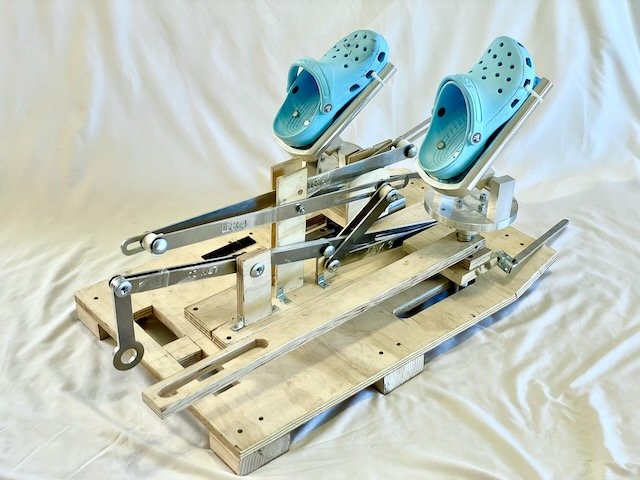Impossible Flight Controls
Creating the flight controls for The Impossible Airplane has proved to be a difficult challenge.
For those who have wondered how Jessica manages to fly a Cessna 172 with just two limbs, the truth is, she can’t. The standard controls of most aircraft, designed for those with full limb mobility, can be operated with two hands and some minor adjustments. However, after an exhaustive search spanning nearly two decades, Jessica was unable to find existing flight controls that could accommodate her needs.
Except for one.
If you already know Jessica’s story, then you know that she found the ERCO Ercoupe. Designed in the 1930s and produced mainly after WWII in the 1940s, the Ercoupe was built from the ground up to have interlinked ailerons and rudder pedals. So, Jessica can put one foot on the throttle and the other on the yoke, and she’s ready to fly.
She is limited to about 30 minutes of safe flying time and a max endurance of around 90 minutes. With the Ercoupe’s top speed of 90 MPH, that means she doesn’t get very far. This was one of the primary reasons we conceived of The Impossible Airplane.
In early 2021, Jessica and I presented her story and a little bit about our goals of creating The Impossible Airplane at an EAA meeting in Mesa, AZ. Dr. David Margolis heard about the meeting and decided to fly up in his RV-10. Once he heard about our goals, he connected us with a unique undergrad program at the University of Arizona with the hopes of designing some of the modifications Jessica needs.
The UA Interdisciplinary Capstone Project brings together seniors from various engineering programs to create teams to work on special capstone projects, and RFI was lucky enough to be selected for the design of the primary flight controls.
Alejandro Lopez (Aerospace), Simon Quang Minh Ly (Aerospace & Mechanical), Renatto Miguel Ramos (Aerospace), Zachary Thach (Mechanical), and Sheehab Zaman (Electrical & Computer) were selected for this project.
The team started the semester by brainstorming a wide variety of ideas for the controls. They also needed data to ensure that their designs could meet the flight control inputs of an RV-10. So, Jessica and I hit up a local LA Fitness and collected data on Jessica’s leg strength in a variety of directions. She pushed, kicked, twisted, and flexed on nearly every piece of leg equipment available.
By the end of the first semester, the team had an idea of how Jessica could move to input the motions of her legs into controls for The Impossible Airplane. They spent the remaining semester mechanically linking their input designs to the control rods positioned under the pilot seat and to the rudder pedals.
The prototype controls designed by students from the UA Interdisciplinary Capstone Project 2023
Here’s how they worked:
Rudder: Two foot sleds, one for each foot, were directly linked to the rudder pedals. These sleds slid forward and backward. Because they were linked with the existing rudder system, as one slid backward, the other slid forward and vice versa. These sleds were designed so that Jessica could pull on one sled, so she only needed one foot on the controls once she was in cruise.
Ailerons: Each sled was mounted on a rotating pole. These poles were interlinked so that Jessica could rotate both feet and, through a series of connections, control the ailerons. The interlink meant that Jessica could control roll with either foot. The interlink wasn’t present on the prototype, but the students were able to show their concepts for it. For the prototype, the ailerons were controlled by rotating the right foot.
Elevator: The complexity of the design became more apparent when considering the elevator subsystem. With both feet able to slide forward/backward and rotate, connecting a pitch control that also included enough leverage posed a significant technical challenge. The sleds allowed Jessica to rotate her ankle up and down. The prototype converted this motion from the left foot into a more exaggerated motion for pitch control.
Brakes: Although not shown in the image above, a pair of levers extended from the floor in a “V” shape. Squeezing these together with her thighs allowed Jessica to control the independent breaking of each main wheel. When in the air, a latch held the breaks in their fully engaged (straight up) position.
If you watched the video at the top, you’ll know that the design was connected to a simulator, and Jessica was able to use it to control an RV-10 in X Plane 12 (the makers of X Plane support The Impossible Airplane).
Alejandro, Simon, Renatto, Zachary, and Sheehab, these remarkable individuals took what most people would consider an impossible challenge and transformed it into a reality. Their groundbreaking work on designing the first six-axis aircraft controls for feet alone, at least the first in history that we know of, is truly awe-inspiring. We deeply appreciate and commend their exceptional innovation.
As a thank you to the students, we brought their design to AirVenture 2023. Not everyone from the team was able to attend, but let us know in the comments if you caught Simon at our booth.
The design did garner some feedback during our evaluation and while being exhibited at AirVenture. There is concern about so many linkages for the pitch control, not only if linkages fail but also if something else falls in and jams the system. Because the system would be directly connected to the control rods, a jam on the PIC side would also mean jamming the controls on the copilot side.
Still, the design was a great leap forward for The Impossible Airplane. More updates will follow this post on our progress with the various modifications. If you would like to support our efforts, click the donate button at the top of the screen.
Thank you. We couldn’t do this without your generous support.


